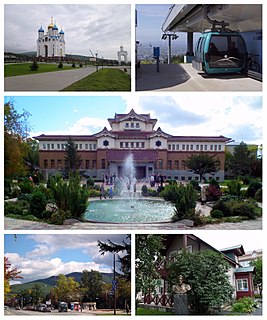 W
WThe Imperial Crown Style of Japanese architecture developed during the Japanese Empire in the early twentieth century. The style is identified by Japanese-style roofing on top of Neoclassical styled buildings; and can have a centrally elevated structure with a pyramidal dome. Outside of the Japanese mainland, Imperial Crown Style architecture often included regional architectural elelements. Before the end of World War II, the style was originally referred to as Emperor's Crown Amalgamate Style, and sometimes Emperor's Crown Style.
 W
WThe Aichi Prefectural Government Office is the main building of the government of Aichi Prefecture. It is located in the city of Nagoya.
 W
WGovernment House, located on Government Hill in Central, Hong Kong, is the official residence of the Chief Executive of Hong Kong. It was constructed in 1855 as a Colonial Renaissance-style building, but was significantly remodelled during the Japanese occupation, resulting in the current hybrid Japanese-neoclassical form.
 W
WIde Kaoru was Chief Architect of the Governor-General's Office in Taiwan, when the nation was part of the Japanese Empire. He held office in the Building and Repairs section of the Japanese Government-General in Taiwan, and was mainly involved with government and municipal building projects. His distinctive architectural ideas influenced the Taiwanese architectural profession. He was born in Gifu Prefecture Japan.
 W
WItō Chūta was a Japanese architect, architectural historian, and critic. He is recognized as the leading architect and architectural theorist of early 20th-century Imperial Japan.
 W
WThe Judicial Building is a governmental building in Zhongzheng District, Taipei, Taiwan. It houses several judicial agencies of Taiwan, includingJudicial Yuan — the judiciary and constitutional court of the government of the Republic of China on Taiwan, Taiwan High Court, Taiwan High Prosecutors Office, and Disciplinary Sanction Court.
 W
WThe Kaohsiung Museum of History is a museum located in Yancheng District, Kaohsiung, Taiwan. It is administered by the Kaohsiung City Government.
 W
WThe Kaohsiung Vision Museum is a museum in Sanmin District, Kaohsiung, Taiwan.
 W
WMasatsugu Kobayashi was a Japanese architect who predominately designed government buildings. His most notable works are the Meiji Memorial Picture Gallery and the Hori Shoten building in Tokyo.
 W
WMeiji Memorial Picture Gallery is a gallery commemorating the "imperial virtues" of Japan's Meiji Emperor, installed on his funeral site in the Gaien or outer precinct of Meiji Shrine in Tōkyō. The gallery is one of the earliest museum buildings in Japan and itself an Important Cultural Property.
 W
WNagoya City Hall is the city hall of the city of Nagoya, Japan.
 W
WOkada Shinichirō (岡田信一郎) was a prominent Japanese architect who practiced in the early twentieth century. Okada taught at Waseda University and Tokyo School of Fine Arts.
 W
WSeoul City Hall is a governmental building for the Seoul Metropolitan Government in South Korea, in charge of the administrative affairs of Seoul. It is located in Taepyeongno, Jung-gu, at the heart of Seoul. It is connected to City Hall Station (Seoul) on Seoul Subway Line 1, with access to Seoul Subway Line 2 from the same station. In front of the current city hall is the old city hall building, now Seoul Metropolitan Library, and Seoul Plaza.
 W
WShimoda Kikutarō was an architect who created the prototype of the Imperial Crown Style for the Japanese Empire. He was a native of Akita, in northern Honshu, and moved to Tokyo in 1881, when he was fifteen. At Keio University, he enrolled in an architecture course under Josiah Conder.
 W
WYuzhno-Sakhalinsk is a city in Sakhalin island, and the administrative center of Sakhalin Oblast, Russia. It is located in the Far East part of Russia, situated north of Japan. Gas and oil extraction as well as processing are amongst the main industries on the island. It was called Vladimirovka (Влади́мировка) from 1882 to 1905, then Toyohara during its period of Imperial Japanese control from 1905 to 1946. As of the 2010 Census, its population was 181,728.